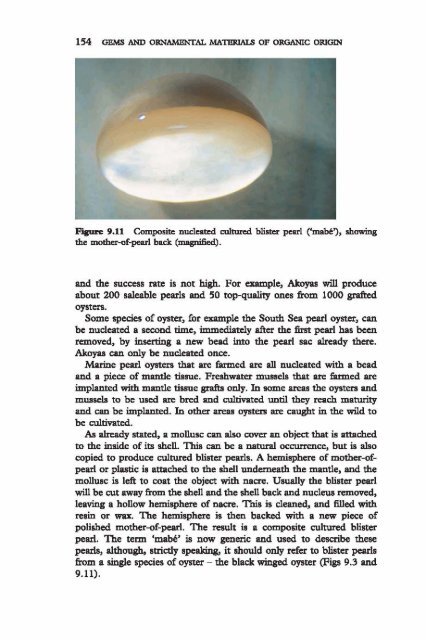Gem and Ornamental
Gem and Ornamental
Gem and Ornamental
Create successful ePaper yourself
Turn your PDF publications into a flip-book with our unique Google optimized e-Paper software.
154 GEMS AND OKNAMENTAL ~~ OF ORGANIC ORIGINFqure 9.11 Composite nucleated cultured blister pearl (hbt'), showingthe mother-of-pearl back (mqnihl].<strong>and</strong> the success rate is not high. For example, Akoyas will produceabout 200 saleable pearls <strong>and</strong> 50 top-quality ones hm 1000 graftedoysters.Some species of oyster, for example the South Sea pearl oyster, canbe nucleated a second time, immediately after the h pearl has henremoved, by inserrjng a new bead into the pearl sac already there.Akoyas can only be nucleated once.Marine pearl o m that are farmed are all nucleated with a bead<strong>and</strong> a piece of mantle tissue. Freshwater mu~sels that are farmed areimplanted with mantle tissue grafts only. In some areas the oysters <strong>and</strong>mussels to be used are bred <strong>and</strong> cultivated until they reach maturity<strong>and</strong> can be implanted. In other areas oysters are caught in the wild tobe cultivated.As already stated, a mollusc can also cwer an object that is attachedto the inside of its ahell. Tlis can be a natural occurrence, but is alsocopied to produce cultured blister pearls, A hemisphere of moth=-of-pearl or plastic is amched to the shell undernea~ the mantle, <strong>and</strong> themollusc is left to coat the object with nacre. Usually the blistex pearlwill be cut away from the bell <strong>and</strong> the shell back md nucleus removed,leaving a hollow hemi~phere of nacre. This is cleaned, <strong>and</strong> filled withresin or wax. The hemisphere is then backed with a new piece ofpolished mother-of-pearl. The mult is a composite cultured bli~terped. The term 'mabt' is now generic md used to demibe thesepearls, although, strictly speaking, it should only refer to blister pearlshm a single species of oyster - the black winged oyster (Figs 9.3 <strong>and</strong>9.11).



